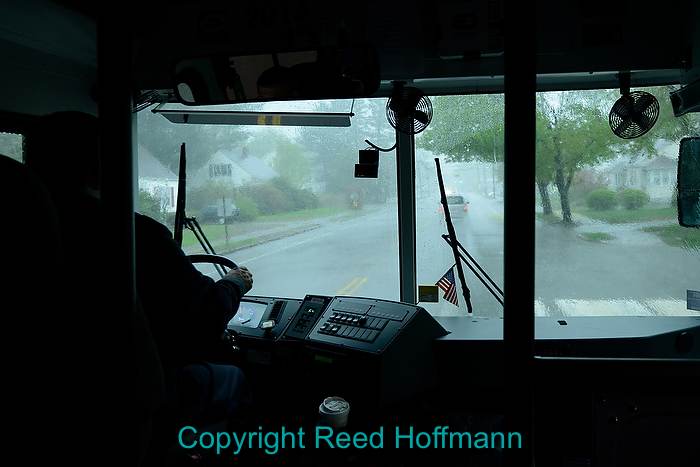I know good photos can be made in all kinds of weather. But there’s weather, and then there’s rain. I’m fine shooting pictures in any kind of weather except rain. Hot, cold, snowy, windy, humid – I can deal with all of those. But keeping lenses, viewfinders and my glasses clear in rain is a constant pain. Not to mention keeping the camera working. Having said that, though, I know good pictures can be made in rain. And I had a reminder of just that a few days ago. Last week I left Kansas City for Portland, Maine, to teach a workshop for Popular Photography’s Mentor Series.
The forecast going in was bad, with a high probability of rain each day. I packed my usual stuff – plastic bags, umbrellas, hat, raincoat and rainpants – and we warned everyone ahead of time. At first it looked like we might get lucky. On our initial shoot Friday afternoon we had blue sky with a few clouds. The evening “sunset” shoot at a lighthouse worked fine too, though there were heavy clouds and occasional sprinkles. The next morning, though, was a different matter.
Saturday dawned with us on the bus, plowing through driving rain and standing water on the way to our first shoot. We made sure everyone was properly prepared, and urged all to carry a minimum of gear (which makes it easier to keep it dry). Arriving, the other instructor (Bill Durrence) and I left everyone on the bus while we met with the fishermen and scouted locations. Settling on three spots that could be gotten to with a minimum of slipping and sliding, we returned to the bus to prep the group for the shoot. Umbrellas? Check. Covers for cameras? Check. Dry wash cloths to wipe lenses dry (from the hotel)? Check.
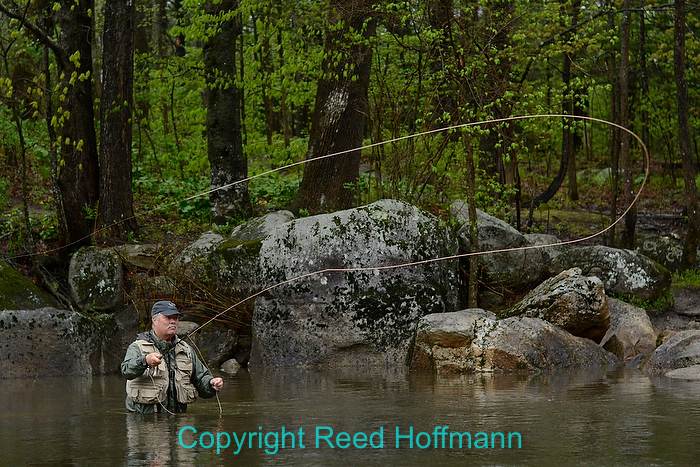
This was the reason we were out that morning, to shoot John and two other fishermen working the creek. I shot at both high and low shutter speeds to stop action (like this one) as well as create blur.
Nikon D7100, Aperture Priority, ISO 1000, 1/2000 at f/2.8, EV -2.0, 50mm f/1.8 lens at 50mm. Photo copyright Reed Hoffmann.
Then it was off into the rain, to try to make pictures. For the next hour we worked the woods and banks around the fishermen. Of course by the time we finished an hour later, the rain had let up to a light drizzle, so I decided to keep everyone off the bus just a little longer. I’m a fan of giving myself assignments with a time limit, to push me to be more creative. So I did that with them, giving everyone twenty minutes to see how many different pictures they could find in those woods next to the gravel parking lot. With that assignment they spread out, looking for lines, patterns, color, texture – all those things that can stand alone, or work together to catch our eye and make a picture. I always suggest you start with your wide-angle eyes, looking over the entire scene to see if a picture can be made there. And if not, then switch to your telephoto or close-up eyes, looking for details. All of us were drawn to the rich greens, made possible by the combination of spring growth and rain.
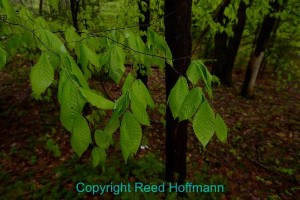
First I look wide, seeing if there’s a scene that brings multiple elements together. I find that most effective if I can have a large foreground subject, like these wet leaves. I got this angle by holding my camera up above the leaves to shoot down.
Nikon D800, Aperture Priority, ISO 320, 1/200 at f/5.6, EV -0.7, 16-35mm lens at 22mm. Photo copyright Reed Hoffmann.
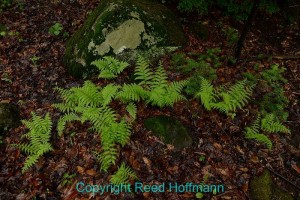
The forest floor can be rich in photo subjects, and ferns are always great fun to shoot because of their shape. Heavily underexposing can help their bright color pop out from the surrounding ground cover.
Nikon D800, Aperture Priority, ISO 320, 1/160 at f/5, EV -2.0, 16-35mm lens at 22mm. Photo copyright Reed Hoffmann.
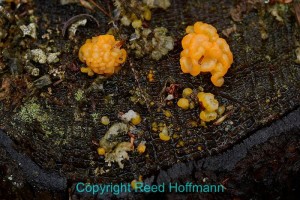
This bright mold growing on a tree stump caught my eye as I walked past. Despite not having a close-up lens I was able to get this framing with my 50mm lens and DX body. I intentionally kept the curve of the bark along the bottom as a compositional element.
Nikon D7100, Aperture Priority, ISO 200, 1/320 at f/3.5, EV -1.3, 50mm f/1.8 lens at 50mm. Photo copyright Reed Hoffmann.
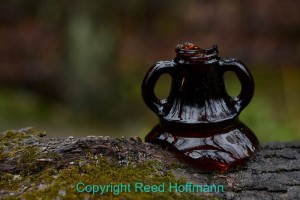
Not every subject there was native to the woods. This was part of a collection of broken bottles someone had arranged on a log.
Nikon D7100, Aperture Priority, ISO 200, 1/125 at f/2.5, EV -2.7, 50mm f/1.8 lens at 50mm. Photo copyright Reed Hoffmann.
Once found, the challenge then was to find the best way to frame the shot, and work with exposure, white balance and depth of field to make a picture from it. As I walked the woods with them, it was fun to see how much they were enjoying themselves. By then we were all used to the wet, and were focused on our picture-finding skills, not the rain. And that, to me, is the key. If you’re prepared for the weather, if you accept you can’t change it and that good pictures can be found, you’re going to be successful. As the instructor, that success for me came as we were boarding the bus to leave. As she climbed on, one woman said, “I’ve always avoided going out in the rain to take pictures, but no more. Now I’m going to make a point of doing just that.” She’s right, and we should all remember that. So the next time it rains, put on your boots, grab an umbrella and get out there. I bet you find some great photos!
(If you’re interested in taking a workshop with me this summer, check out the Montana trip I’m leading for Popular Photography’s Mentor Series. We’re going to Glacier National Park, a game farm (bear and cougar) and Native American Days. We’re going to have a great time, rain or shine!)

